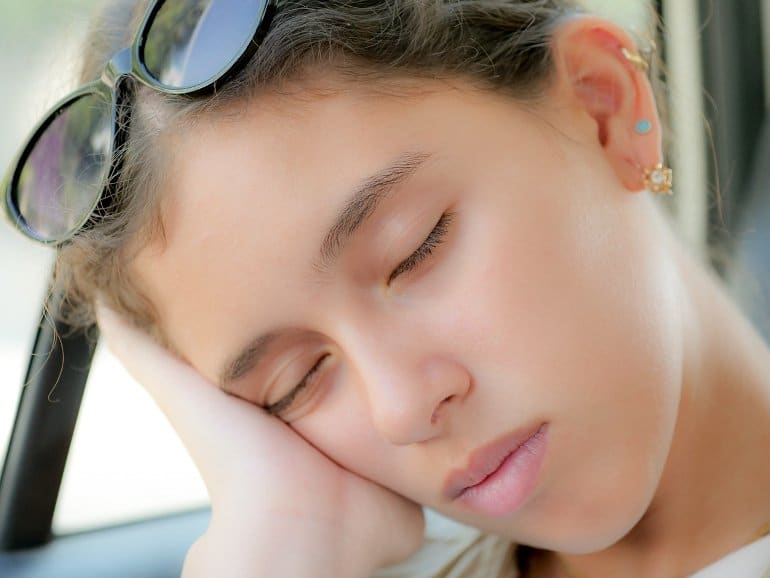Summary: Controlled nighttime use of social media and apps can help ease teenagers’ negative thoughts before they fall asleep, a new study reports.
Source: Flinders University
Overuse of mobile devices gets a bad rap but an upside may be their ability to create a distraction and positively affect teenagers’ ability to get to sleep, new Flinders University research shows.
Feedback from more than 600 teenagers from age 12 to 18 at South Australian schools between June and September 2019 has led the international research group to point to a more nuanced view on using the wide range of mobile content – led by Youtube, music apps, Instagram and Snapchat – before young people’s bedtime.
“Many teenagers struggle with a racing mind when sleep doesn’t come easy,” says lead corresponding author Dr Serena Bauducco, a visiting postdoctoral researcher from Örebro University, Sweden.
“This study shows that many adolescents use technology to distract themselves from negative thoughts, which may help them manage the sleep-onset process. Thus, distraction may be one mechanism explaining how sleep affects technology use, rather than vice-versa,” the study concludes.
The majority of 631 adolescents surveyed used technology as a distraction from negative or distressing thoughts, with 23.6% answering “yes” and 38.4% “sometimes,” according to the study published in the journal Sleep Advances (Oxford Academic).
However, the study did reveal a higher tendency of app use among the young people with existing sleep problems compared to those not reporting a sleep problem, leading researchers to caution that other solutions are needed to help teenagers to fall asleep.
Passive entertainment, via music apps or Youtube video clips, or interacting with peers via Instagram or Snapchat were considered the most popular distractions.
First author of the study, Flinders University psychology graduate Ms Alexandra Daniels, says the complex relationship between sleep and technology is illustrated by a tendency for some adolescents with sleep problems to more frequently use devices before bed.
“This study helps to provide evidence to suggest that the relationship between teenagers, technology and sleep is much more complex than the previously accepted idea that technology use prior to sleep onset is always negative and harmful,” she says.

South Australian child and adolescent sleep expert Professor Michael Gradisar, who conceived the idea behind the study, says the research suggests that recommendations for focused use of certain apps could become an integral part of some adolescents’ sleep routines, to help them regulate their negative thoughts.
Flinders University sleep psychology graduate Professor Gradisar, who now focuses on a range of technologies as Head of Sleep Science at Sleep Cycle in Sweden, says good sleep habits from infancy through adolescence is important to set healthy sleep routines into adulthood.
Respondents in the study were asked which app was likely to distract them from any negative or distressing thoughts – from messaging, phone calls, Instagram, Facebook, Snapchat, Twitter, Youtube, Reddit, Tumblr and the Spotify/iTunes/Apple Music, Netflix/Stan, Viber/WhatsApp, gaming app, audiobook or ‘other’.
Participants reported multiple technology preferences including mobile phone, iPad, laptop, desktop computer, iPod/MP3 player, television, gaming console or ‘other’.
Researchers note the recent rise in popularity of TikTok and other apps in a rapidly changing field.
A previous study in Sleep Medicine by the Flinders University researchers aligned use of phones, laptops and gaming consoles by secondary school students in the hour before bed, or in bed before sleep onset, were associated with increased odds of insufficient sleep in school nights.
“Evening technology use should be monitored for feasible limits and harm minimisation because technology will remain an integral part of adolescents’ evenings,” they conclude.
The National Sleep Foundations recommends that adolescents aged 14-17 years sleep between 8 and 10 hours per night.
About this neurodevelopment and sleep research news
Author: Tania Bawden
Source: Flinders University
Contact: Tania Bawden – Flinders University
Image: The image is in the public domain
Original Research: Open access.
“Technology use as a sleep-onset aid: are adolescents using apps to distract themselves from negative thoughts?” by Serena Bauducco et al. SLEEP Advances
Abstract
Technology use as a sleep-onset aid: are adolescents using apps to distract themselves from negative thoughts?
Study Objectives
The aim of this study was to; (1) explore whether adolescents use technology as distraction from negative thoughts before sleep, (2) assess whether adolescents who perceive having a sleep problem use technology as distraction more compared to adolescents without sleep complaints, and (3) collect qualitative information about which devices and apps adolescents use as a distraction.
Methods
This study used a mixed-methods cross-sectional design, where 684 adolescents (M = 15.1, SD = 1.2, 46% female) answered both quantitative and qualitative questions about their sleep (perceived sleep problem, sleep onset time (SOT), and sleep onset latency [SOL]) and technology use as distraction from negative thoughts.
Results
The majority of adolescents answered “yes” or “sometimes” using technology as a distraction from negative thoughts (23.6% and 38.4%). Adolescents who answered “yes” to using technology as distraction were more likely to report having a sleep problem, longer SOL, and later SOT, compared to adolescents who answered “no”. The most popular device to distract was the phone, because of its availability, and the most common apps used for distraction included YouTube, Snapchat, and music apps.
Conclusions
This study shows that many adolescents use technology to distract themselves from negative thoughts, which may help them manage the sleep-onset process. Thus, distraction may be one mechanism explaining how sleep affects technology use, rather than vice versa.






